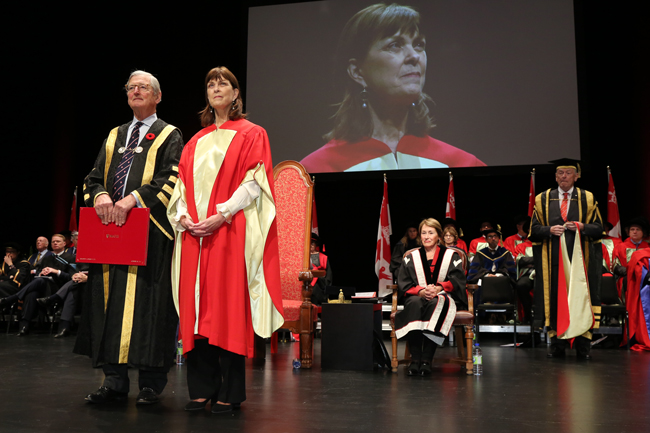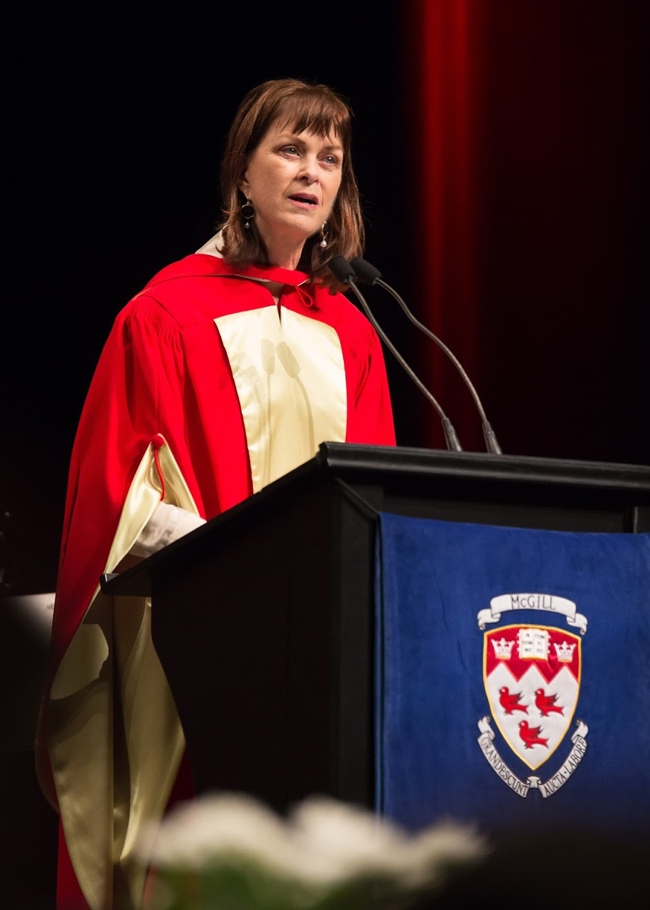
In 10 years as McGill’s Principal and Vice-Chancellor, Heather Munroe-Blum gave her fair share of speeches at Convocation. But none of them were quite like the one she delivered this morning, after she was conferred with an honorary doctorate (Doctor of Science honoris causa) as part of 2017 Fall Convocation ceremonies.
The Principal Emerita began by telling the audience that the day was fraught with emotions for her. Almost immediately she had to fight back tears when she spoke about her husband, Len Blum. “How grateful I am to you, Lenny, for the love and support we have shared for almost 50 years,” Munroe-Blum said. “Without this I most certainly would not be standing here today.”
The Principal Emerita told the audience that, in preparing her address, said had taken her daughter’s advice to tell the story of her life and to “speak your truth, mom.”
“This is a personal story, just that,” Munroe-Blum offered as a simple preamble.
“On my third birthday I was rushed to a children’s hospital where I was diagnosed with polio. My mom was told that I would never walk again,” said Munroe-Blum, one of hundreds of thousands of children who were stricken by the polio virus during the epidemic of the 1950s.
“The disease would’ve killed me as it did many other children around the world except for a few lucky breaks,” continued McGill’s first-ever female Principal.
“I was sent to the Hospital for Sick Children that was staffed with nurses, doctors and researchers who were dedicated to extending the lives of children like me. My muscles were too weak to draw air into my lungs so I was put into a piece of modern technology – an iron lung – which kept me alive through the crisis of the disease,” said Munroe-Blum.
Months into her stay at the hospital, Munroe-Blum was still desperately ill, “fragile and paralyzed,” she said.
The kindness of strangers
A retired physiotherapist (“a complete stranger”) volunteered to take Munroe-Blum, now wearing a full metal body brace, into her home for treatment. Munroe-Blum lived there for one year, following a physiotherapy regimen that completely went against the widely-accepted treatment of the day, which was bedrest.

“This woman drew on her vast experience with patients like me and her own observational talents to offer me a different treatment,” said Munroe-Blum. “Each day she removed my braces, carried me to her ironing board and spent the day pumping my legs back-and-forth.
“The time spent being cared for by that remarkable woman is filled with positive memories of being on her ironing board, of looking out at her beautiful Victorian garden, of her telling me the story of the Little Engine that Could,” she said “I hear her voice say ‘I think I can. I think I can. I think I can,’ over and over again as she moved my legs.”
One year later, Munroe-Blum returned to her family’s home with only small braces on her lower legs. “I could walk,” she told the audience quietly but triumphantly.
Her rehabilitation continued at the Hospital for Sick Children, driven to and from by volunteer drivers from the Kiwanis Club week after week after week. “I was taught to swim,” she said. “And every week I swam a little further.
“When I was five years old I walked into kindergarten with neither crutches nor braces,” Munroe-Blum said. “I looked just like all the other excited five-year-olds.”
That same year, Munroe-Blum pointed out to the audience, polio began to be eliminated in North America. “A devastating disease eradicated through the achievement of scientific research – the discovery of the polio vaccine by Dr. Jonas Salk.”
Anything but a miracle
The Principal Emerita skipped ahead to Grade Three, when a substitute teacher doing roll call paused at Munroe-Blum’s name. The teacher told the confused child to approach her desk.
“Astonishingly [the teacher] began to cry,” said Munroe-Blum. “She said ‘I was a nurse on your ward in the hospital when you were in an iron lung. We thought you would never walk again and were worried you might die. But you didn’t die and you can walk. It’s a miracle.’
“Now you might take these facts and come to the conclusion, like that teacher, that my extraordinary progress was a miracle. But you would be wrong. Or you might come to the conclusion that, as a child, I had some greater source of courage, some greater power of will than other children. But again you would be wrong. There are other truer reasons why I am literally standing here,” said Munroe-Blum.
“I am standing here because I lived in a place that had outstanding, well-funded public institutions dedicated to the advancement of science and knowledge, state-of-the-art technology and dedicated to informed practice,” continued Munroe-Blum. “I am here because they were individuals, both professionals and volunteers, who did not accept tragic outcomes, who did not accept standard practices that didn’t show a positive effect, who believed they must find a better way.
“I’m here because I live in a country that has certain values. It values its citizens, it values the effort to achieve a high standard of health and education for everyone,” said Munroe-Blum, her voice wavering at times. “It values institutions dedicated to pushing both the horizons of knowledge and the applications of that knowledge. It values individuals with vision, courage and determination to use their lives to make a difference.”
Turning her address back to the audience, Munroe-Blum challenged graduates to be like the many people who had had positive impact on her life in those trying early years. “When you leave this hall today, when you walk out into the daylight of your future, hold onto these values. Don’t accept a tragic outcome. Don’t accept pessimism or mediocrity.
“Today at this moment in your lives I urge you to find your truths, what ever these may be. They will lead you around corners, over hills and through valleys never imagined. Embrace your strengths and see your challenges simply as goals to be reached in your own way,” said Munroe-Blum in closing. “Lift yourself higher, work with those around you to do the same. This is my truth.”
Click on the thumbnail below to watch Heather Munroe-Blum’s Convocation address

I have heard so many convocation addresses that I, sadly, began to see them all blended into one. There are a few that stand out and this is one of them. Thank you, Dr. Munroe-Blum.
Thanks Heather for speaking your truth. The class of 2017 was privileged to hear your story and so are we with the benefit of social media. We are indeed privileged to live in this wonderful country and bring durgiynded by people sharing our values. RBC is lucky to have you on its board and I to have had the pleasure to witness your contributions to Corporate Canada as well. Sincerely,
Francine Blackburn,
A retired RBC executive and McGill alumni
Well done Heather. Your address touched my heart. And I hope the graduates of 2017 hearts were also open by your address.
Thank you for your inspiring words.
Truly Inspiring! Thank You
Bravo, and heartfelt felicitations to my sister Heather: For the eloquence with which your McGill Class of 2017 convocation address has revealed profound truths not only about your own extraordinary recovery from childhood polio, enabling you to go on to fulfill your potential, develop your formidable talents, and achieve unprecedented success personally and professionally, nationally and internationally in the realm of academia in particular, renowned for your visionary leadership and public service contributions not only within Ontario, Quebec, and Canada but globally … With humility and gratitude, publicly acknowledging how your ability to succeed not only in regaining your health… Read more »